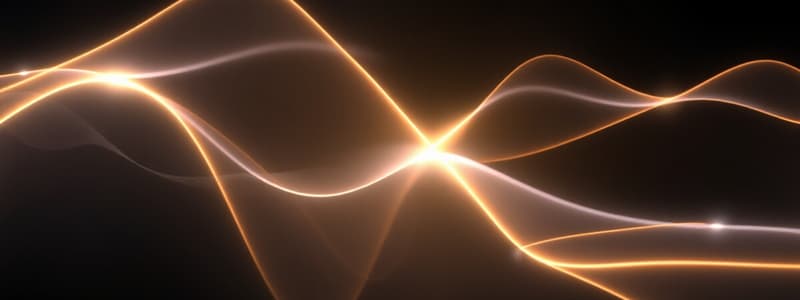Podcast
Questions and Answers
What is the definition of light?
What is the definition of light?
a type of radiant energy
How does light travel?
How does light travel?
travels in waves called electromagnetic waves/radiation
What is amplitude?
What is amplitude?
height of a wave - the brightness of intensity of light depends on the amplitude of waves
What is wavelength?
What is wavelength?
What is frequency?
What is frequency?
What is speed?
What is speed?
What is the equation for wavelength and frequency?
What is the equation for wavelength and frequency?
What are the only electromagnetic waves we can see?
What are the only electromagnetic waves we can see?
What color has the longest wavelength?
What color has the longest wavelength?
What color has the shortest wavelength?
What color has the shortest wavelength?
The color of an object that we see is the color of _____ absorbed.
The color of an object that we see is the color of _____ absorbed.
What is the symbol for amplitude?
What is the symbol for amplitude?
What is the symbol for wavelength?
What is the symbol for wavelength?
What is the symbol for speed?
What is the symbol for speed?
What is Planck's Theory?
What is Planck's Theory?
Is there a relationship between frequency and energy?
Is there a relationship between frequency and energy?
What is Planck's constant?
What is Planck's constant?
Explain the photoelectric effect.
Explain the photoelectric effect.
What idea did Einstein use to explain light?
What idea did Einstein use to explain light?
What is a photon?
What is a photon?
Energy is specific to the _____
Energy is specific to the _____
Light also acts as a _____
Light also acts as a _____
Study Notes
Definition of Light
- Light is a type of radiant energy.
Light's Travel
- Light travels in waves known as electromagnetic waves or radiation.
Amplitude
- Amplitude refers to the height of a wave.
- The brightness and intensity of light are determined by the wave's amplitude.
Wavelength
- Wavelength is the distance between two consecutive crests or peaks of a wave, indicating the "length" of the wave.
Frequency
- Frequency measures how fast a wave oscillates up and down.
- One complete cycle consists of one up and one down movement.
- Frequency is measured in hertz (s^-1).
Speed of Light
- All electromagnetic waves travel at the speed of light, approximately 3.0 × 10^8 m/s.
Wavelength-Frequency Relation
- The relationship between wavelength (λ), speed of light (c), and frequency (ν) is described by the equation: λ = c/ν.
Electromagnetic Spectrum (Left Half)
- The left half of the electromagnetic spectrum includes:
- Gamma Rays: Highly energized, released from explosions.
- X-Rays: Emitted by the sun.
- Ultraviolet Light: Lies beyond visible light.
- Visible Light: Includes colors detectable by the human eye.
- These waves have high frequency, short wavelength, and high energy.
Electromagnetic Spectrum (Right Half)
- The right half includes:
- Infrared: Emitted by the sun, used to detect living things.
- Microwaves: Commonly used in communication and cooking.
- Radio Frequencies: Suitable for radio transmissions.
- These waves possess low frequency, long wavelength, and low energy.
Visible Light
- The only electromagnetic waves that can be seen are visible light.
Color Wavelengths
- Red light has the longest wavelength.
- Violet light has the shortest wavelength.
Color Perception
- The color of an object is determined by the light it absorbs.
Symbols in Light Physics
- Amplitude: Represented by A.
- Wavelength: Represented by lambda (λ).
- Frequency: Typically notated by ν.
- Speed: Just expressed as m/s or nm/s.
Heating and Color Emission
- When heated, certain objects emit specific colors.
Electrons and Colors
- The colors observed are linked to the number of electrons and the atomic structure of an object.
Planck's Theory
- Max Planck proposed that energy could only be emitted or absorbed in specific amounts, termed quanta.
- Energy is quantized, meaning it exists in discrete units.
Theories of Energy
- Classical Theory posits that energy is continuous.
- Quantum Theory asserts that energy is quantized, existing in fixed amounts.
Frequency and Energy Relationship
- There is a direct relationship between frequency and energy.
Energy Equation
- Energy (E) is related to frequency (ν) through Planck's constant (h), described by the equation: E = hν.
Planck's Constant
- Planck's constant is valued at approximately 6.626 × 10^-34 J-s.
Photoelectric Effect
- The photoelectric effect occurs when light hits a metal surface, causing the ejection of electrons.
Einstein and Quantum Theory
- Albert Einstein utilized quantum theory to elucidate the nature of light.
Photon
- A photon is defined as a quantum of energy carried by light particles.
Energy Specificity
- The energy of light is specific to its frequency.
Light as a Particle
- Light exhibits particle-like behavior, reinforcing the concept of duality in its nature.
Studying That Suits You
Use AI to generate personalized quizzes and flashcards to suit your learning preferences.
Description
This quiz focuses on fundamental concepts related to light in chemistry, including its definitions, how it travels, and key properties such as amplitude and wavelength. Each flashcard presents a critical term, effectively aiding in the understanding of light as a form of radiant energy.




